
About the Header
For over 40 years, SwRI has conducted extensive fuel surveys, procuring and analyzing samples from service stations across the nation. In 2023, the team conducted over 200,000 analyses of nearly 43,000 fuel samples.
For more than 75 years, Southwest Research Institute has been involved in nearly every facet of automotive and transportation research from powertrains to fuels and lubricants to intelligent highways and connected and automated vehicles. In 2023, many of these programs focused on sustainable mobility and transportation to lower greenhouse gas emissions. SwRI continued existing programs and launched new ones aimed at safe, low- and zero-emission, energy-efficient and affordable modes of transport, including electrified powertrains and alternative fuels. Connecting vehicles and intelligent infrastructure also offers solutions to mobility and safety on the road. SwRI develops a broad spectrum of automated driving systems with autonomy solutions for vehicles designed to traverse urban roadways, off-road environments and military battlefields.
Automotive
SwRI is investing in and expanding its research into hydrogen, a simple, carbon-free molecule that can fuel rockets and automobiles and store energy. We recently installed a 17,000-gallon liquid hydrogen tank on our main campus to provide a cost-effective, reliable supply of hydrogen to support a range of initiatives with this carbon-free energy source. For example, SwRI is leading a joint industry program to demonstrate the potential to replace heavy-duty diesels with hydrogen-fueled internal combustion engines as a pathway to eliminate greenhouse gas emissions in the transportation industry. Paired with SwRI’s aftertreatment hardware and control strategies, this engine will produce only trace amounts of nitrogen oxide (NOx) and CO2 emissions, offering an additional technology solution along with battery electric and fuel cell vehicles in the fight against climate change. SwRI also developed hydrogen powertrain and fuel cell research facilities to help the transportation industry develop new fuel cell technologies and improve the durability, reliability and performance of current fuel cell systems.
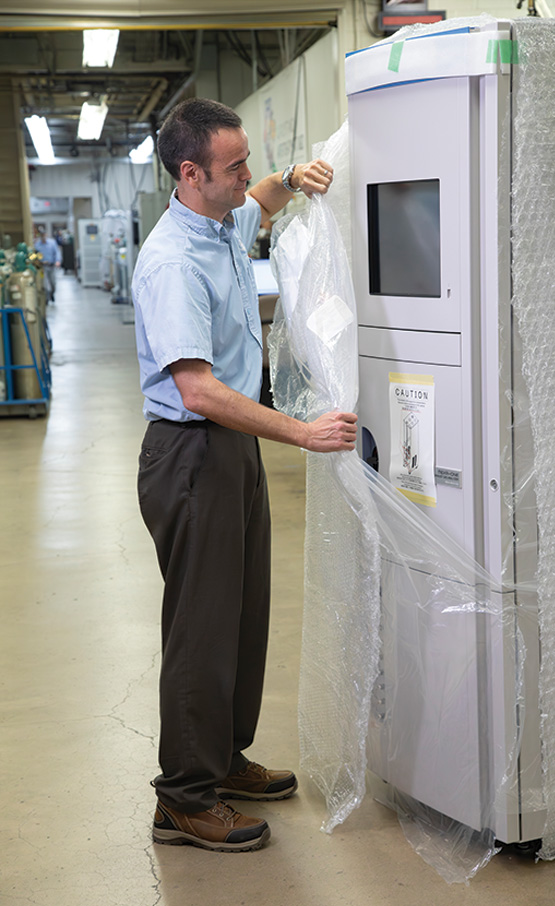
SwRI offers several new, state-of-the-art emissions carts to enhance its emissions measurement and analysis capabilities.
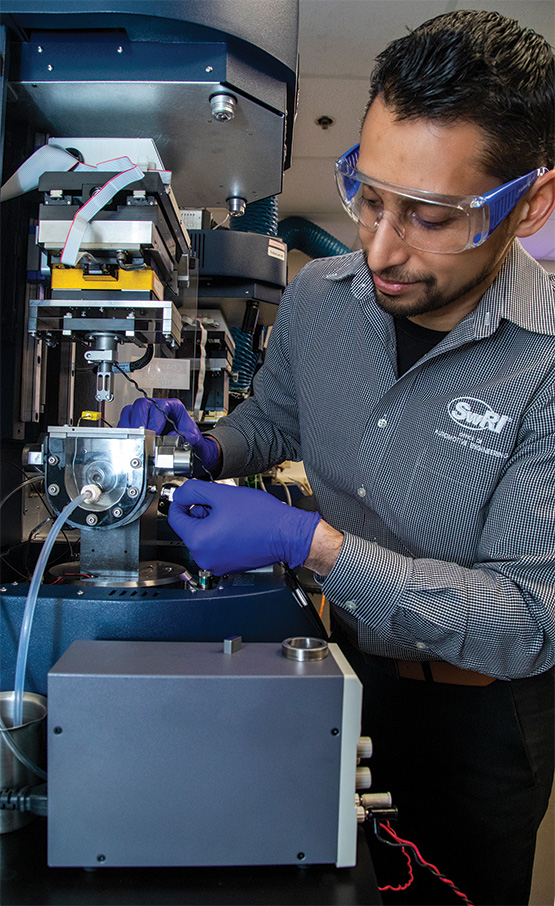
Engineers demonstrate SwRI’s new benchscale test rig for fluids formulated for electric vehicles. The Institute specializes in creating custom tribology rigs and testing capabilities to allow industry to efficiently evaluate multiple lubricant formulations, without requiring full-scale testing.
In 2023, the U.S. Environmental Protection Agency approved SwRI’s ECTO-Lab™ technology to assess the durability of engine emissions control systems to support certification processes for new diesel engine families. Developed using internal research funding, SwRI’s patented burner technology accelerates the aging of diesel engine aftertreatment systems by 10 times that of conventional aging processes, providing a cost-effective solution for aftertreatment screening and durability demonstrations.
An SwRI project funded by DOE demonstrated an average of 15% energy savings when connected and automated vehicles (CAVs) are integrated into traffic. The project used actual traffic data, specialized testing equipment and computer modeling to quantify the benefits of incorporating SwRI’s eco-driving framework into different types of vehicles, studying how those vehicles affected traffic flow. According to the researchers, as more CAVs are introduced into traffic, roadway efficiency improves enough to, under the right conditions, reduce overall energy consumption by 15% without affecting trip time and traffic flow. The program built upon SwRI research funded by DOE’s NEXTCAR program.
SwRI completed a nearly 10-year, comprehensive initiative to reduce NOx by 90% in future heavy-duty diesel trucks for the California Air Resources Board, the EPA and heavy-duty truck OEMs. The engine achieved this significant NOx reduction without increasing fuel consumption or carbon dioxide production. Datasets from this program will inform technology standards for the upcoming 2027 EPA emissions requirements.
To help the heavy machinery industry meet net-zero emissions goals, SwRI engineers are studying how to cost-effectively electrify mine hauling trucks, which can measure up to 65 feet long and weigh roughly 500 tons. Using internal research funding, researchers developed rigorous test setups to evaluate and characterize mechanical, electrical and thermal abuse for battery technology designed to power massive mine hauling trucks. SwRI developed tests to simulate the environments, altitudes, shock and vibration scenarios, crush potentials and fire safety issues that a mine hauling truck might face during continuous, 24-hour operations.
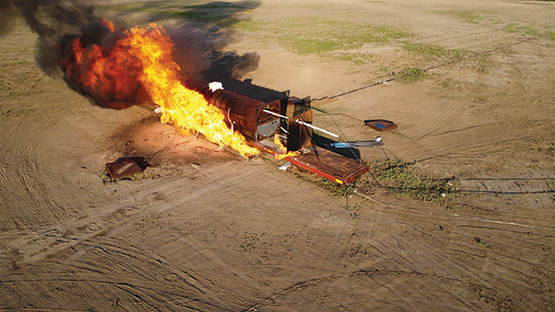
SwRI exposed a cryogenic storage tank filled with liquid natural gas to a pool fire, demonstrating that its pressure release system performed as designed, maintaining tank integrity.
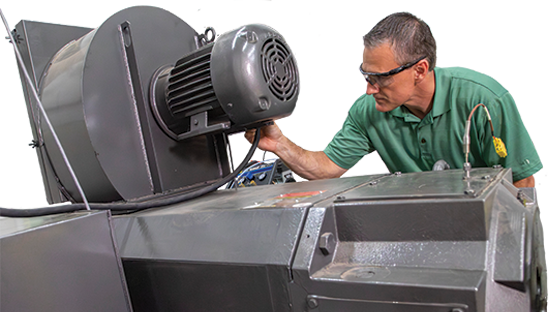
To support SwRI sustainability goals, engineers outfitted several test cells with regenerating drives to absorb engine power, converting up to 90% into electricity to offset power consumption or feed into the grid.
As the automotive and transportation industry transitions from internal combustion engines toward electric and hybrid-electric powertrains, SwRI is studying fuels and lubricants to ensure they are optimized and adapted to these new environments. With more than 70 years of experience working with engines, fuels and lubricants for traditional drivetrains, SwRI is well-positioned to study how fluids perform in electrified drivetrains through internally funded projects and industry collaboration.
In 2020, SwRI launched the Advanced Fluids for Electrified Vehicles (AFEV) consortium to help industry develop and optimize EV fluids and advance the design of EV powertrains. This year, AFEV grew and evolved to meet specific industry needs. SwRI is leading two complementary, internally funded projects to characterize the real-world stresses to fluids in electric or hybrid-electric vehicles and assess a “failed” fluid at the end of its life. The two programs involve running a battery electric vehicle and plug-in hybrid for the equivalent of 100,000 miles on SwRI’s mileage accumulation dynamometers. Researchers take periodic fluid samples from these vehicles to understand how electrification affects fluid degradation and breakdown over time.

SwRI evaluated eco-driving enabled vehicles using modeling, test tracks and dynamometers, finding that, as connected and automated vehicles are introduced in traffic, overall roadway efficiency improves, decreasing energy consumption by 15% without affecting trip time and traffic flow.
SwRI is also studying how the electric currents and magnetic fields produced by EVs influence fluid environments, leading EV lubricant aeration testing with a new custom test stand. Researchers recently modified commercial tribology testing devices to accurately test friction and wear associated with fluids operating in electrified environments.
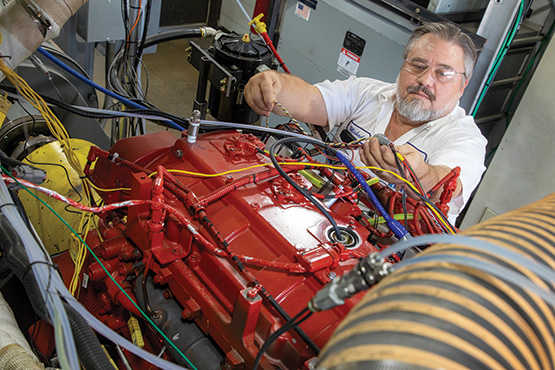
SwRI paired this hydrogen demonstration engine with low-NOx aftertreatment and control strategies, paving the way for future heavy-duty trucks that produce only trace amounts of NOx and CO2.
SwRI chemists have launched a study to better understand the fluid chemistry involved in heat oxidation of vehicle catalyst systems. A team of SwRI fluid and lubricant researchers are examining how proposed next-generation, carbon-reducing technologies might affect fluids and how variables — such as the addition of hydrogen, nitrogen and ammonia to engines as well as stray voltages from electric drivetrains, etc. — might affect vehicle system longevity. Through this internally funded program, SwRI will be prepared to address future client challenges.
The Institute’s cost-effective bench-scale testing capabilities allow clients to test multiple lubricant formulations efficiently, accelerating lubricant optimization, improving hardware durability and increasing vehicle range through reduced friction. Similar benchtop efforts are ongoing, with SwRI engineers working to modify an industry standard oxidation test to include testing for oxidation in an electrified environment.
For over 40 years, SwRI has conducted major national fuel surveys evaluating fuel samples collected from retail service stations across the nation. Over the years, SwRI has developed a network of independent contractors to collect pump nozzle samples and prepare them for shipment to SwRI for testing. In 2023, SwRI received nearly 43,000 samples and conducted over 200,000 analyses on these samples.
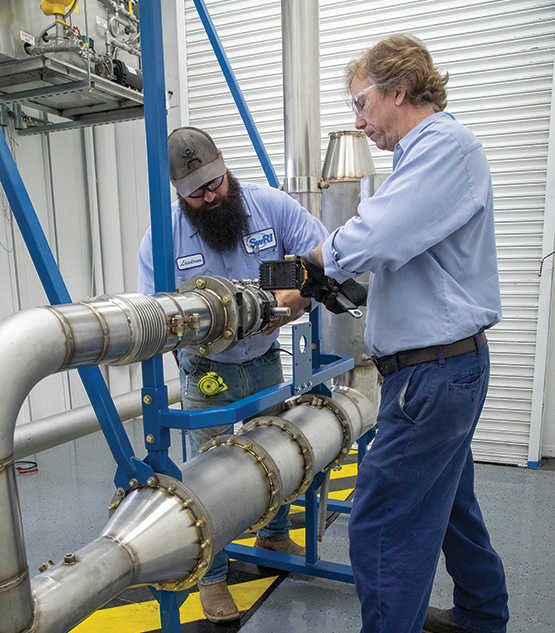
Developed using internal research funding, this patented ECTO-Lab™ burner technology ages catalyst systems 10 times faster than traditional techniques, evaluating the systems’ life cycles more efficiently.
SwRI launched an extensive two-year effort to update its powertrain engineering testing capabilities, including 30 engine test cells that often operate 24 hours a day, seven days a week, 365 days a year. We are upgrading four of these cells with state-of-the-art dynamometers, emissions measurement technology and associated infrastructure to support longer, more robust testing.
To update fuels and lubricants test facilities and automotive infrastructure in preparation for new testing categories and an overall expansion of project scope, SwRI added new cooling towers, updated high-voltage and high-amperage electrical breakers, and installed regenerating drives, allowing dynamometers to recover energy and offset power consumption or feed into the grid.
Transportation
SwRI is a leader in intelligent transportation technology, developing traffic management systems used by a growing number of organizations and agencies to improve traffic flows on increasingly congested roadways. We are improving integration of state and local systems with new data streams to enhance mobility and safety with machine learning, networks and cloud-based solutions.
A quarter of the United States’ population travels roads supported by SwRI-developed Intelligent Transportation Systems (ITS) deployed by state and local transportation agencies. In 2023, SwRI added two new states to its ActiveITS™ advanced traffic management system deployments. Puerto Rico, Oregon, California, Utah, New Mexico, Texas, Kansas, Arkansas, Tennessee, Kentucky, Florida, Pennsylvania, Maryland, Vermont, New Hampshire and Maine all use ActiveITS to manage their roads. We are developing a browser-based client interface to improve accessibility.

Using SwRI’s Active-Vision™ software, a new tool automatically assigns a vehicle’s GPS location based on its proximity to a traffic camera. This technology will allow clients to position traffic cameras wherever desired, providing opportunities for new metrics.
We are developing and deploying a data exchange system for the Florida Department of Transportation that will also be adapted for use by the Pennsylvania Department of Transportation. The system integrates high volumes of information from connected vehicles and other transportation data sources, processing data in real time to detect and address actionable roadway conditions. It also archives vast quantities of data for research and analytics to aid in transportation planning, roadway safety improvements and other advances.
The Tennessee Department of Transportation recently went live with the Interstate-24 Smart Corridor system using the SwRI-built SmartWay Central Software platform. Initially focusing on lane control signs and variable speed limits, the corridor has already reduced accidents by 20–40%. An artificial-intelligence-based decision support system developed by Vanderbilt University will be integrated by SwRI to further reduce accidents and decrease the propagation of traffic slowdowns. Additional development will manage the arterial diversion of traffic during major incidents to enhance throughput and mitigate roadway congestion.
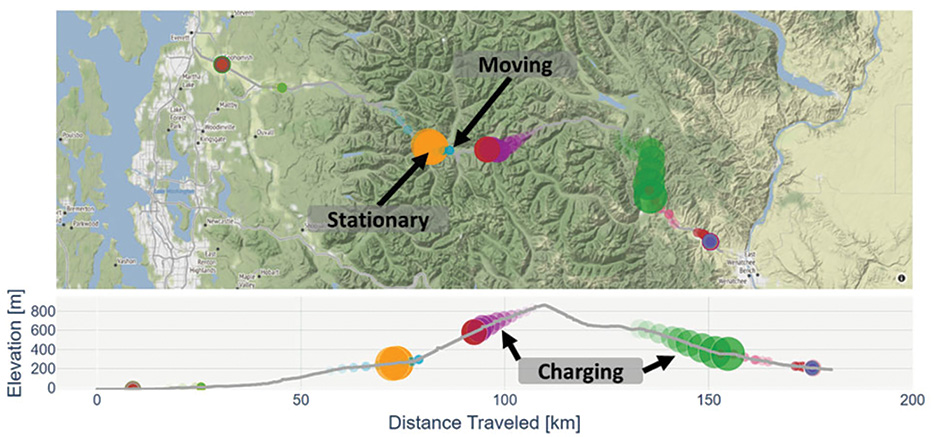
ALTRIOS software simulated a route through the Cascade Mountains in Washington state, showing a battery-electric locomotive’s state of charge (indicated by the dot size). ALTRIOS accounts for trains stopping to allow others to pass (orange), battery usage as trains climb mountains (red) and regenerative battery charging as trains descend the mountain (green).
SwRI created a computer vision system that assigns a real-time GPS location to vehicles based on its proximity to a traffic camera. The auto-localization capability featured in SwRI’s Active-Vision software can recalibrate the localizing system in a robust, accurate way. This technology will allow our clients to expand beyond a handful of preset configurations and let them position traffic cameras wherever desired, enabling speed detection and traffic volume measurements while also detecting incidents like stalled vehicles and wrong-way drivers.
SwRI is also helping the freight rail industry assess decarbonization technologies with an open-source modeling and simulation software. ALTRIOS — the Advanced Locomotive Technology and Rail Infrastructure Optimization System — simulates the real-world impacts and expenses related to adopting alternative energy locomotive technologies and expanding associated infrastructure. SwRI’s Locomotive Technology Center shared its modeling and locomotive expertise with the National Renewable Energy Laboratory (NREL), the University of Texas at Austin, the University of Illinois Rail Transportation and Engineering Center and BNSF Railway. The project was funded by the U.S. Department of Energy Advanced Research Projects Agency–Energy. ALTRIOS is available for download at the NREL website.
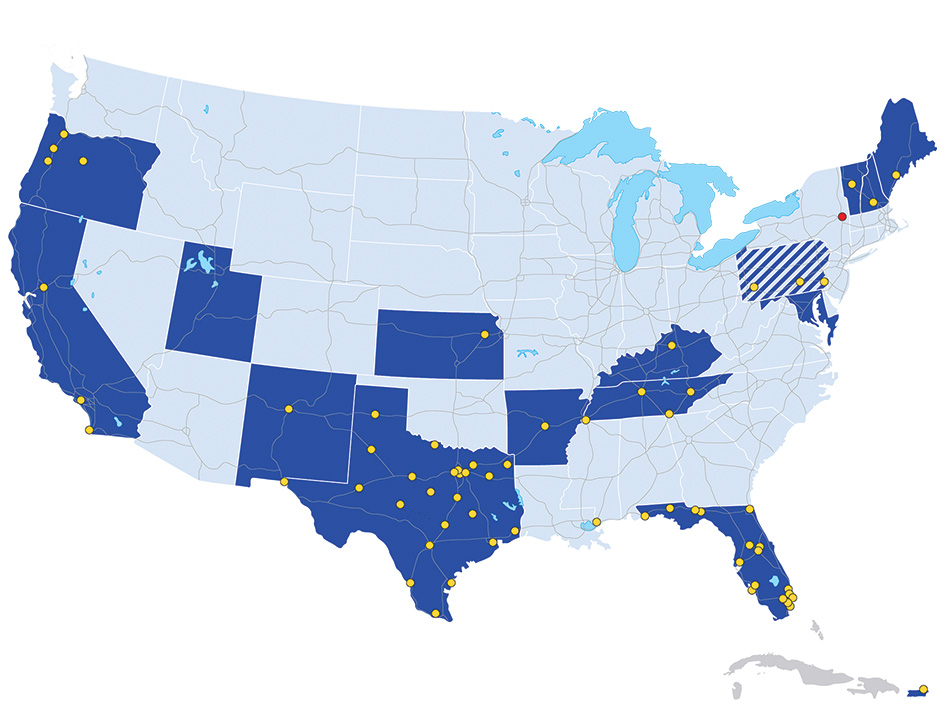
SwRI supports over a quarter of the United States population with Intelligent Transportation Systems (ITS) deployed by state and local transportation agencies. ActiveITS is fully deployed statewide in dark blue states and is fully deployed in cities indicated by yellow dots. The red dot indicates a pilot program city.
